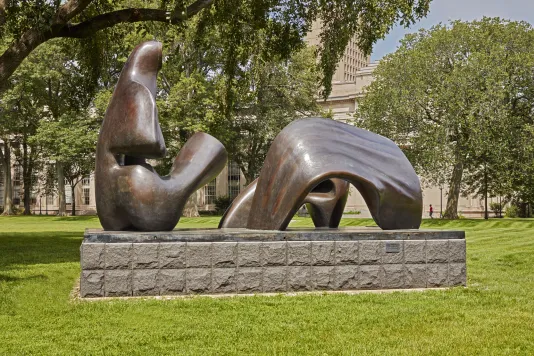Henry Moore, Three-Piece Reclining Figure, Draped, 1976. Gift of the Eugene McDermott Family and Other Friends of MIT. © The Henry Moore Foundation. All Rights Reserved, DACS 2025 / www.henry-moore.org. Photo: Charles Mayer Photography
Three-Piece Reclining Figure, Draped, 1976

One of Henry Moore’s dominant themes was the human figure in repose. He began sculpting reclining bodies in 1929, inspired by pre-Columbian chacmool sculptures, which depicted Yucatan rain deities, and by sculptures from the east pediment of the Parthenon, which show Zeus giving birth to Athena through his head.
Moore’s reclining figures similarly connote gods and goddesses of nature, rivers, and seasons—the earth and its elements. Even Moore’s figurative work, however, tends toward abstraction. In Three-Piece Reclining Figure, Draped, the tallest element’s cavities and protrusions suggest a head, neck, breasts, arms, and hips, though the figure seems to have been interrupted at the points where the head and the legs might connect. The shorter, disconnected elements suggest the missing bent legs from some angles. Yet, here as in other works, the rounded shapes reduce, separate, and simplify human anatomy, at times veering closer to the forms and contours of rocks, shells, and landscapes. These characteristic shapes express Moore’s belief in a close affinity between man and nature, sculpture and landscape.
Moore’s desire for his sculptures to mimic the natural environment played into his experiments with space, a primary concern of modern sculpture. During the 1960s, he began to break his sculptures of reclining figures into segments and pierce them with holes to reveal internal forms and frustrate a sense of cohesion, encouraging the viewer to walk around the work to understand its full articulation. He also grouped distinct forms to create a composite work. While these decisions at times create ambiguities and tensions within and among forms, they also exemplify Moore’s search for equilibrium between material and void, mass and space.
Henry Moore (1898–1986) is regarded as one of the foremost British sculptors of the twentieth century. After a two-year course at Leeds School of Art, Moore was awarded a scholarship to study sculpture at the Royal College of Art in London in 1921. Perhaps more influential than his coursework were his visits to the British Museum: his early sketchbooks indicate his interest in Paleolithic fertility goddesses; Cycladic and early Greek art; and Sumerian, Egyptian, Etruscan, Oceanic, Peruvian, and Pre-Columbian sculpture. Almost all of Moore’s own works from the 1920s and 1930s are carved sculptures, initially inspired by pre-Columbian stone carving, that exhibit his respect for the character of stone or wood. Another early influence was the work of Paul Cézanne, which Moore encountered on his first visit to Paris in 1923. Moore’s sculpture of the 1930s reflects the artistic developments in Paris, particularly the work of Pablo Picasso, Hans Arp, and Alberto Giacometti. After the mid-1950s, the sources for many of Moore’s sculptures were natural forms such as bones, shells, pebbles, and flint stones. During the last fifteen years of his life, he devoted his time to drawing, and printmaking also became a major part of his work in the late 1960s; by the end of his life, he had produced more than 700 prints.
